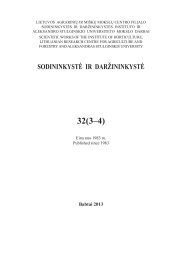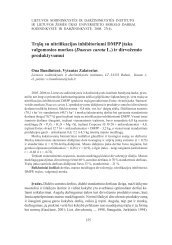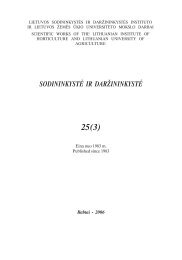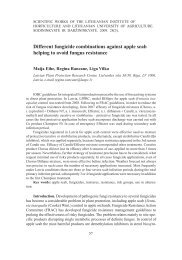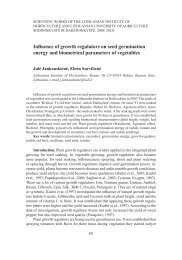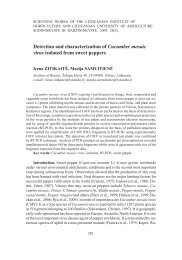31(1–2) - Sodininkystė ir daržininkystė - Sodininkystės ir ...
31(1–2) - Sodininkystė ir daržininkystė - Sodininkystės ir ...
31(1–2) - Sodininkystė ir daržininkystė - Sodininkystės ir ...
Create successful ePaper yourself
Turn your PDF publications into a flip-book with our unique Google optimized e-Paper software.
easons of the study, innovation. Should indicate the aim of the investigation.– Object, methods and conditions– ResultsShould present concisely the collected data during investigation, documentation(tables, figures).– DiscussionShould not repeat results presented in “Results” but should interpret themwith reference to the results obtained by other authors, explain the reasons of theinvestigated phenomena and raise new ideas, hypotheses.– Conclusions– Acknowledgements (optional)– ReferencesShould be kept to a minimum of 10 latest references on this theme.– Summary in Lithuanian and English (600–1 400 characters)Articles written based on non-traditional trial data and the obtained resultsmay have other than traditional structural parts of a paper.The article should not exceed 10 pages of computer text, tables and figuresincluded (longer articles are agreed with the cha<strong>ir</strong>man of the Editorial Board).Text preparationThe manuscripts should be submitted in Lithuanian and English, typed on aPC, used Microsoft WORD for Windows 2000 XP or VISTA word-processorformat. The font to be typed – TIMES NEW ROMAN size 12, on A4 paper(210 × 297 mm), single spaced, justified. Margins: top – 2 cm, bottom – 2 cm,right – 1.5 cm, left – 3 cm. Article should be submitted in electronic carrier.In bold there are written the title of the paper in all languages, headings and allmain structural elements (introduction, object, methods and conditions, results,discussion, conclusions, acknowledgements, references, abstract). In Italic thereare written Latin names of species, genera, diseases, pests micro-organisms andother biological objects. Names of plant cultivars should be placed within singlequotation marks (for example, ‘Auksis’).The quoted reference in the text is indicated in round brackets (author’s surname,year).TablesInformation given in figures or other illustrations, should not be repeated intables.Text in tables is written in Lithuanian and English languages. If Lithuanianand English texts are in one line they are separated by /. Do not use vertical andhorizontal lines to separate parts of the text. A horizontal line separates only headingsof columns and the end of the table. Orientation in a page only vertical(Portrait).Trial variants in tables should not be numbered or submitted in complicated91



